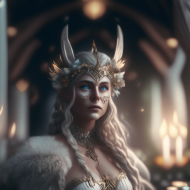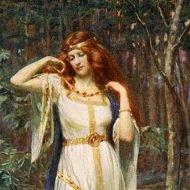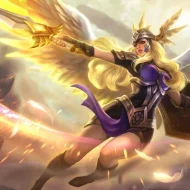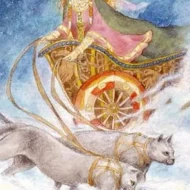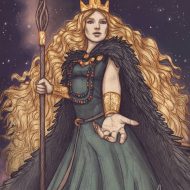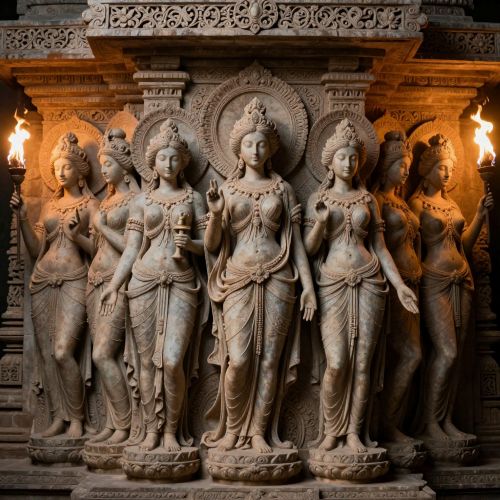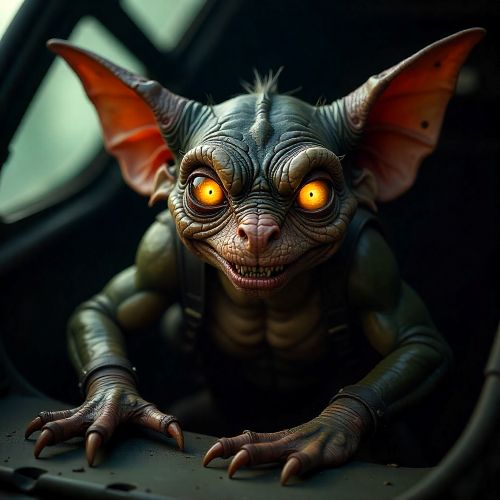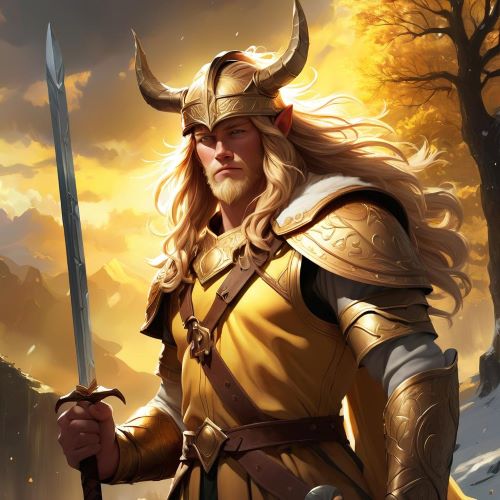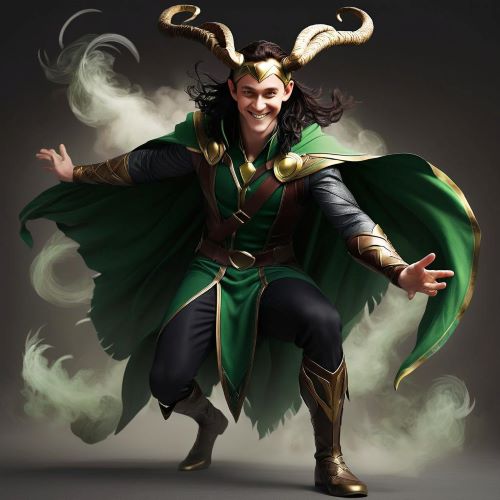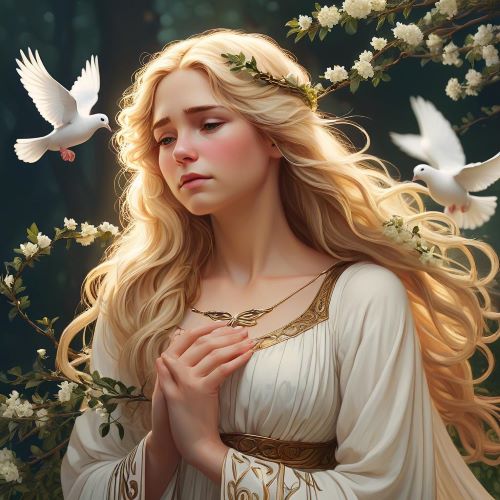Freya : Goddess of Love
Listen
At a glance
| Description | |
|---|---|
| Origin | Norse Mythology |
| Classification | Gods |
| Family Members | Njord (Father), Nerthus (Mother), Freyr (Brother), Odr (Husband), Hnoss, Gersemi (Daughters) |
| Region | Scandinavia |
| Associated With | Lust, Love, Fertility |
Freya
Introduction
One of the most prominent Norse goddesses is Freyja, who was the sister of Freyr. She was in charge of fertility, love, death, and battle. Her father was the sea god, Njrd. She rode a boar with a golden bristles and a cat-drawn chariot.
It was Freyja’s privilege to choose the half of the heroes who died in battle to her great hall at the Flkvangard. The god Odin took one of the half to Valhalla, while the other half went to Brsinga. Freyja also had a valuable necklace, which Loki stole. The watchman of the gods, Heimdall, was eventually recovered. She was also accused of teaching witchcraft to the members of the Aesir tribe.
Physical Traits
While she did not usually carry weapons of war, Freya was known to have various other items. One of these is a cloak made out of falcon feathers, which gave people the gift of flight. Her most prized possession was the torc, which was referred to as Brisingamen.
She was also known to ride a glittering chariot, which was pulled by two cats. Her usual companion was a hog known as Hildisvni, who was referred to as “battle swine.” Her common epithet, Sr, was probably derived from her association with this animal.
Family
Freya was the child of Njord, who was a god of the Vanir who was associated with the sea, fishing, fertility, and wealth. Although her mother’s identity is not known, some believe that she was the daughter of Nerthus, who was a goddess of plenty and peace. Nerthus was said to have been associated with an archaic ritual that involved a cart procession and the laying down of arms.
Freyr was Freya’s brother, and he was a god of wealth and prosperity who was depicted with a phallus like that of fertility deities. She married Odr, a god who was mysterious and passionate. He was often on the go, and it was believed that his absence caused Freya to cry out for gold. They had two daughters, Gersemi and Hnoss. The names of their children both meant “treasure.” It was not clear who Odr and Freya were. It was believed that Freya was a version of Frigg, and it was possible that Odr was Odin.
Other names
The name Freya, which means “the lady,” was derived from the Germanic word frawjon, which literally means “high social standing.” It was also the origin of the word frau, which literally means “married woman.” It was believed that Freya was first used as a nickname or an epithet by a Germanic tribe. Eventually, it would become a popular name.
She was often referred to as Gefn the giver, the flaxen haired Horn and Mardoll, the sea shaker and also credited with given the day of the week Friday it’s name.
Powers and Abilities
Freya is a master of seiðr, a form of Norse magic that allows practitioners to shape fate and foresee the future. She introduced this mystical art to the gods, making her one of the most influential figures in Norse mythology. She also presides over Fólkvangr, a realm where half of the fallen warriors go after death, while the other half are taken to Odin’s Valhalla.
Freya possesses several magical artifacts, including:
- Brísingamen, her enchanted necklace.
- Falcon cloak, which grants her the ability to fly.
- Chariot pulled by cats, a unique mode of transportation symbolizing her connection to fertility and domestic life.
Modern Day Influence
During the 19th century, Freya’s cultural popularity was brought back by Germanic nationalism. She was even mentioned in Denmark’s national anthem, which read “There is a lovely land, Freya’s hall.” Her appearance in Richard Wagner’s opera, Der Ring Nibelungen, also helped to galvanize German nationalism in Northern and Western Europe. Most of the popular modern depictions of Norse mythology featured Freya, but in the movies and comics released by Marvel, Frigga incorporated some of her personality.
Related Images
Frequently Asked Questions
What god is Freya?
Freya stands as a prominent and multifaceted goddess within Norse mythology, belonging to the Vanir tribe. Her influence spans a diverse range of domains, encompassing love, beauty, and fertility, as well as the contrasting aspects of war and death. Notably, she is also linked to wealth and the practice of seiðr, a potent form of magic. As the twin sister of the god Freyr, Freya holds a significant position in the Norse pantheon, embodying a compelling blend of sensuality, strength, and mystical power.
Who is Freya to Thor?
Freya and Thor belong to different tribes within the Norse pantheon; she is Vanir, and he is Aesir. They do not share parents, as Thor is Odin’s son and Freya is Njörðr’s daughter. While not closely related, their paths intersect in some myths, such as the tale where Thor disguises himself as Freya. Therefore, their relationship is more of fellow deities within the same overarching mythology rather than close kin.
Who got Freya pregnant?
Based on the information available, Freya had two daughters, Hnoss and Gersemi, with her husband Óðr. The myths do not mention Freya having children with any other god.
Is Freya Odin's wife?
No, Freya is not Odin’s wife. Odin’s wife is the goddess Frigg.
Did Freya love Loki?
The relationship between Freya and Loki in Norse mythology is characterized by a mix of occasional alliance and significant conflict, rather than romantic affection. While they interact in some myths, such as Freya lending Loki her falcon cloak, the poem Lokasenna reveals Loki’s intense hostility and accusations against her. Furthermore, Loki is implicated in the theft of Freya’s cherished necklace, Brísingamen.
Watch
Sources
Davidson, H. R. E. (1964). Gods and myths of Northern Europe. Penguin Books.
Lindow, J. (2001). Norse mythology: A guide to gods, heroes, rituals, and beliefs. Oxford University Press.
Simek, R. (1993). Dictionary of Northern mythology. Boydell & Brewer.
McCoy, D. (n.d.). Freya. Norse Mythology for Smart People. Retrieved from https://norse-mythology.org/gods-and-creatures/the-vanir-gods-and-goddesses/freya/
Mythopedia. (n.d.). Freya. Retrieved from https://mythopedia.com/topics/freya


